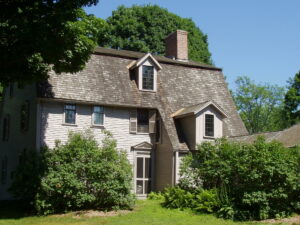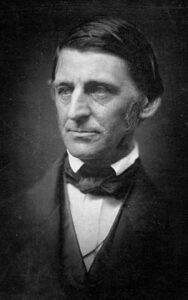By David Wilkening, Contributing Writer

CONCORD – The modest-looking house would been famous just for its location: on the banks of the Concord River, just a half mile from where the first shots of the Revolutionary War were fired. You can see the old battle site from the home’s top floor.
Name came from original owner
But what some visitors immediately want to know: Why in the world do they call it “The Old Manse?” It’s admittedly an old-fashioned word that was used at times to describe where a minister lived. That is entirely apt since it was built by Reverend William Emerson, Concord’s patriot minister. He was also the grandfather of someone far better known to us today: Ralph Waldo Emerson.
The house was his home. But also the home of Nathaniel Hawthorne and his wife, Sophia. Henry David Thoreau and other familiar figures of American cultural and literary history also had connections to the home.
After being closed during the pandemic, The Old Manse is now again offering tours and individual visits. “Ralph Waldo Emerson as a child lived in the house and later as an adult for a time. He and Hawthorne were friends. It’s most likely they and other intellectuals of the time were in overlapping circles as members of prominent and well-connected families,” said Steve Schroth, education manager of The Old Manse.
It is almost an understatement to say this historic house and grounds has one of the richest histories in America. It has witnessed the beginnings of the American Revolution, the lives of great 19th century American writers, and the beginning of the transcendentalism movement.
The Reverend Emerson completed construction on The Old Manse, a two-and-a-half story clapboard, Georgian-style house, in 1770. Five years later on April 19, 1775, the Battle of Lexington and Concord erupted on the North Bridge―about a half mile away. Rev. Emerson and his family witnessed the fighting at Concord’s North Bridge from their second-floor windows.
The more famous Emerson as an adult described it in memorable terms: It was “The shot heard around the world.”
Transcendentalism began here

Emerson not only grew up in the house but also began his adult writing career there. Nature writing in New England began at the house, as visitors learn. Emerson wrote the first draft of his famous essay in the upstairs study with its windows overlooking the North Bridge conflict. It was here he wrote “Nature.” The short tome, published in 1836, is known today as the first thoughts on Transcendentalism―a once popular philosophical movement. The basic thrust of it was a non-traditional appreciation of nature.
Long after the American Revolution, the area and the house itself drew like-minded intellectuals of the times. One was novelist Nathaniel Hawthorne, author of “The Scarlet Letter.” Hawthorne was then a young writer destined to become among America’s greatest. His wife Sophia was an artist who also found success. Together they planned to each develop their respective crafts while inspiring the other. Sophia promptly transformed the dining room into her painting studio. She was believed to be the first female American painter paid for her work.
Hawthorne wrote much about the house and surrounding landscape which later appeared in his “American Notebooks” and “Mosses from an Old Manse.” The writer was the first to name it The Old Manse.
Thoreau among well-known visitors
The couple moved into the Manse in 1842. They were newlyweds, and friend and fellow transcendentalist philosopher Henry David Thoreau was one of their early visitors. He surprised them with an heirloom vegetable garden planted in front of the house. Visitors today can see a recreated version of it.
The Hawthornes lived in The Old Manse for three years. They wrote poetry to each other. Today, it’s still etched into the window panes. Sophia even used her engagement ring to carve her name on the glass.
“That’s one of the most popular things for visitors,” Schroth said of the poetry.
The house had other connections to the conservation movement in Massachusetts. Ornithologist William Brewster, the first president of the state’s Audubon Society, owned a boat house there for several years.
The Trustees of Reservations purchased The Old Manse in 1939, where visitors can still see the original furnishings. It was designated a National Historic Landmark in the 1960s.
If you go…
After being closed to visitors during the pandemic, it opened again last July. It was open only on the weekends, from 11 a.m. to 5 p.m. But it is now open Wednesday through Monday. Visitors come from various age groups but older visitors represent a substantial percentage of them.
Most visitors prefer joining the tour groups of a half dozen or so rather than visiting on their own. Pre-registration at the site is recommended for tour times. Admission is free for members of The Trustees of Reservations. The cost for seniors over 65 is $10 and adults under 65 is $12. Tours that run daily start at 11 a.m. and last about 45 minutes.
The Old Manse house is not wheelchair accessible and the house is not air conditioned. It also does not have public bathrooms. However, public facilities are available at the nearby National Park Service parking area.
For more information visit: https://thetrustees.org/place/the-old-manse.
RELATED CONTENT:
Stepping into the past at the homes of two famous writers (fiftyplusadvocate.com)
Rockport’s ‘Paper House’ has endured for a century (fiftyplusadvocate.com)
The road ended where it began for ‘The father of the Beats’ (fiftyplusadvocate.com)












